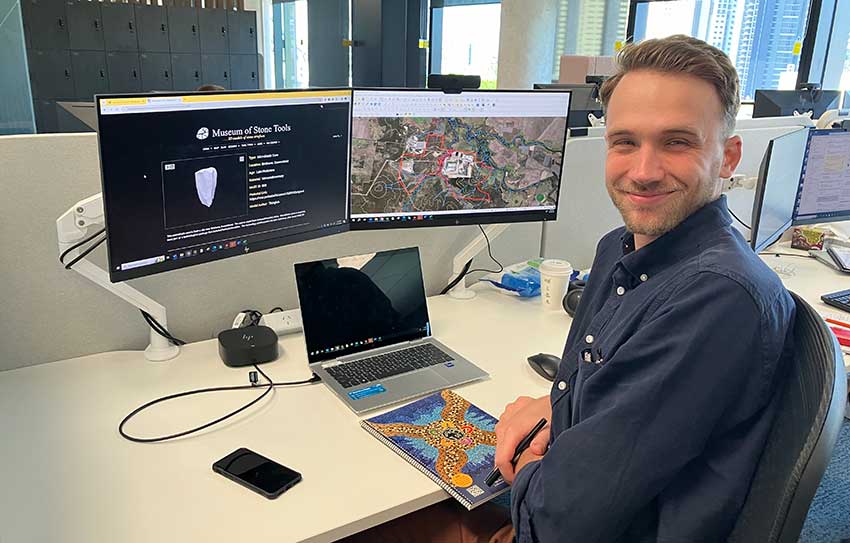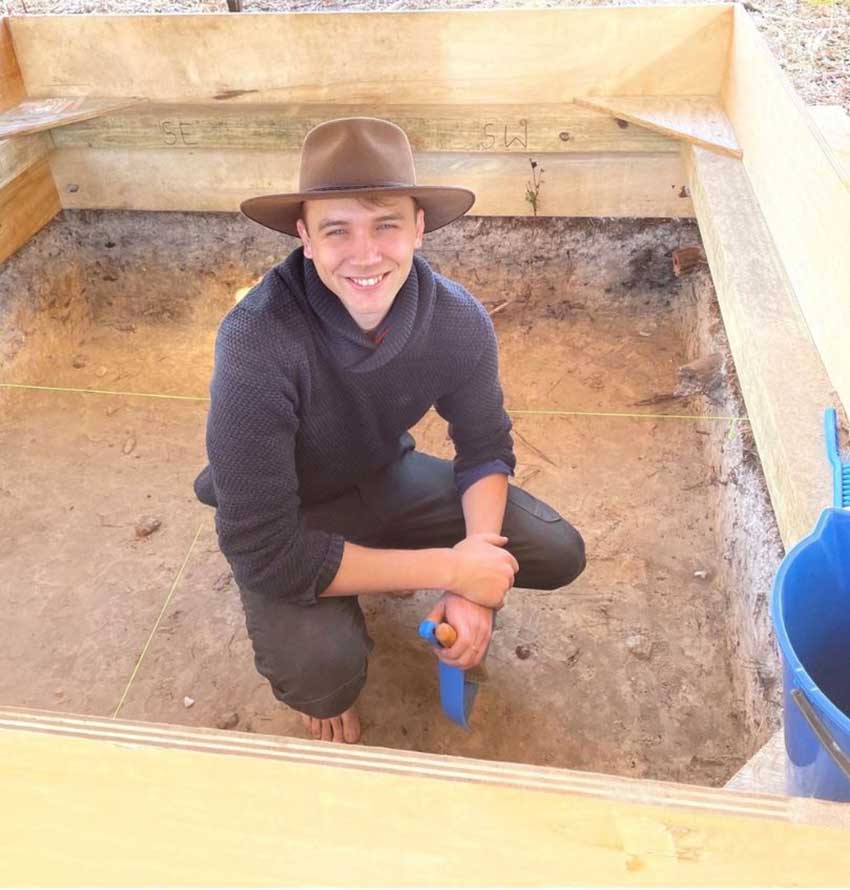26 Mar 2024
- Employees
- Environment
- Community

ARCHAEOLOGY AND ENERGY: AN UNEXPECTED CONNECTION
With the energy transformation underway and new projects being developed, the intersection between science and culture has become an increasingly important part of doing business at CS Energy.
Archaeologist Andrew Binyon joined CS Energy in 2023 as Cultural Heritage Advisor, and said that there is great opportunity to look into the past when building the future.
“Archaeology is specifically about the study of people and understanding the human past,” Andrew said.
“I’ve always believed that to understand the present, and to understand where we’re going as a society and community, you have to be able to look back and figure out how we got here.”
What is cultural heritage management?
Without overarching national heritage laws, each Australian state governs cultural heritage in a different way. In Queensland, it is predominantly about engaging and liaising between companies and Aboriginal parties about a development or major land project on their Country.
“Queensland has a particular set of laws that are related to cultural heritage as well as European history,” Andrew said. “My role is to interpret legislation, ensure compliance is being met from a development perspective, and developing relationships with Aboriginal communities to try and find active, reasonable solutions to challenges in those spaces.
“It’s also about making sure that we have those positive relationships with our Aboriginal partners, and seek their advice and knowledge to ensure their culture, understanding, and stewardship of the land on which we operate is being done in a respectful way that is productive and moving us forward, and not disruptive in any way.
“My role is about looking for ways to ensure development is done effectively, morally, and well, to ensure that no harm is done to cultural heritage. You have to be aware of many things – you’re a master of none in that space – you have to understand a little bit of everything,” he said.
“You also have to have the ability to identify and find cultural heritage on the land.”
Exploring what’s been left behind
One of the ways we can learn about the past is through excavations and understanding what’s been left behind.

“Archaeology is the study of what people leave behind: what’s left over, what’s been discarded, and what you can find,” Andrew said.
“Then you piece the parts of that puzzle that have been left behind to build an image of what happened in the past.”
In Queensland, most finds are lithic artefacts or stone tools which can be anything from a tiny piece of the edge of a blade which was once part of a much larger item to the blade itself.
Aboriginal cultural heritage involves intangible culture as well.
“Scar trees, for example, can be used for a number of different things depending on the type of wood that’s available – such as shields, bowls, or other types of workable material,” Andrew said.
“They can also be used to mark an area of significance, or used in a ceremonial type of way, or to mark a pathway, and all these other ways that have an intangible element to them that you have to understand, which is why we partner with Aboriginal parties to provide that additional context.”
A big step forward
Andrew said that having a role like his in a large business is a huge step forward for the archaeological industry in Australia.
“For a business like CS Energy to have a role like this shows we’re not just thinking about it, it’s something we want to prioritise,” he said.
“Not only in terms of our business development, but also to create a business that is working towards best practice and partnering with Aboriginal communities to ensure that their heritage and custodianship of the land on which we operate is still respected and at the table.
“If we weren’t doing this, there’s a 100 per cent likelihood that we would impact something and irrevocably destroy the opportunity to understand the past more, and lost the opportunity to provide those connections to future generations - for an Aboriginal elder or young Aboriginal kid to see an artefact and say, ‘I understand that, and this is my culture’.
“My work isn’t just about compliance,” Andrew said. “It’s about ensuring that we’re providing the opportunity to protect and preserve the past in a way that is not just about us archaeologists or energy as an industry, but also as Australians.”
An overlooked past
While many people are aware of archaeological sites in other countries, and will travel to see them, early Australian history tends to be overlooked.
“You don’t have to go overseas to be an archaeologist,” Andrew said.
“The oldest civilisation in the world lives here in Australia.
“There’s a misconception that we only have 200 years of European history; but we have proven over 75,000 years of Aboriginal heritage, and that’s just what’s been found so far. There are estimates that go way beyond that.
“We in Australia have the opportunity – and the responsibility – to find and preserve this culture as much as we can, and work with its descendants as much as possible to be able to preserve that.”
Andrew said it’s an interesting time to be an archaeologist in Australia.
“There’s an abundance of cultural heritage and exciting archaeological work here, in industries you wouldn’t expect cultural heritage to be a part of.”
“With the energy transformation happening, the energy industry and CS Energy are at the forefront of trying to rebuild towards this new future, which involves looking at the past and being able to bring that into the conversation of what we’re doing moving forward,” he said.
“It’s a really interesting time and really interesting industry, which I think is overlooked a lot in Australia.”